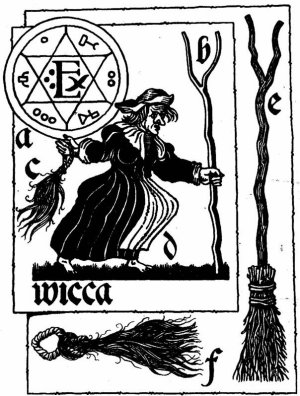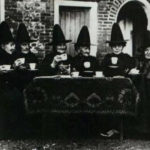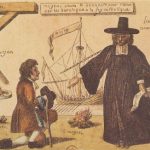In folklore, witches use brooms to fly through the air at high speed and go to the Sabbath. The image of a witch riding a broomstick has then become a popular cultural stereotype. Nevertheless, the correlation between brooms and witches is not noticeable until the late 16th and early 17th centuries and has been mostly popular in continental Europe.

- Brooms are a symbol of female domesticity and most witches were women. If the woman of the house wanted to indicate that she was not at home, she placed her broom outside her front door. By laying it across the door, it was supposed to protect the home.
- The early household broom, or besom, was made from the broom plant, or from birch twigs or heather, and shared some of the traditional lore attached to these plants.
- Many flying ointments contained hallucinogenic ingredients. If a broomstick was rubbed with such potions and used for riding or masturbatory purposes, a sensation of flight would result as the poison easily penetrates the body through the vaginal and anal veins.
- The association between witches and brooms goes back to ancient times, when pagans performed fertility rites to induce their crops to grow high. These people mounted pitchforks, poles, and brooms, and rode them like horses in the fields, leaping high into the air and dancing.
At first, the brush end of a broom (or faggot), was pointed downwards so the witch could “sweep her tracks from the sky.” Nevertheless, by the end of the 17th century, the reverse was true. Witches often rode with the faggot-end up, with a candle in the faggot to light the way to the Sabbath gathering place.
If the witch was inside a house, she theoretically rose through the chimney, although in court, few witches ever acknowledged doing such a thing. Sorcerers flew on brooms as well as witches, but men were more often shown riding pitchforks.
A pitchfork was both a very convenient steed and tool. She could either ride astride the fork, or, when seated backwards upon a goat, she could carry her cauldron between the prongs of the fork. A piece of cloth could also be fastened to the fork in a sail-like fashion. Last but not least, it might also serve as a parachute in case the charm happened to fail suddenly.
Brooms are not only a means of transportation, they can also be used to raise up storms or imitate somebody’s else form. In Hamburg, sailors, after long toiling against a contrary wind, on meeting another ship sailing in an opposite direction, throw an old broom before the vessel, believing thereby to reverse the wind.
A famous Scottish witch of the 17th century, Isobel Gowdie, claimed to have used her broom in an original way. Instead of using it for travelling, she used it to deceive her husband. Before going to a sabbat, Isobel substituted her broom for herself in bed. She said he never knew the difference.
In modern wicca, the broom is used to purify space before a circle is cast. It is related to the element of Water and is used in many water spells involving cleansing.








